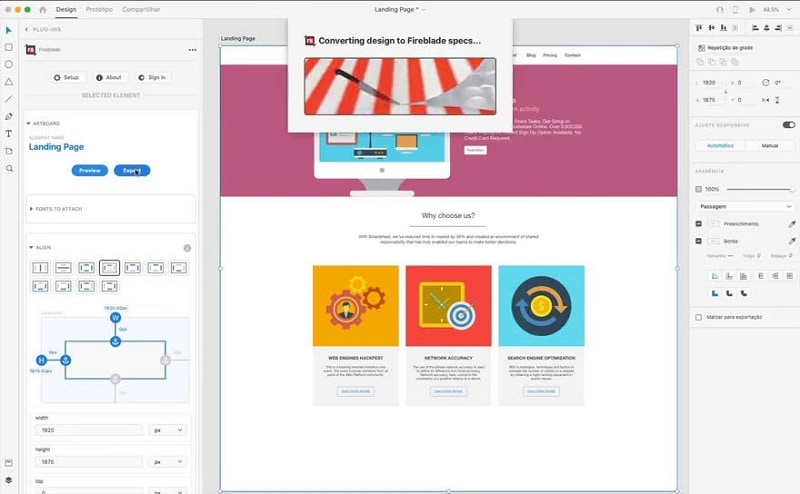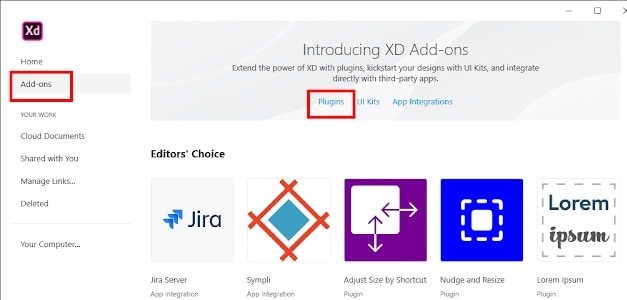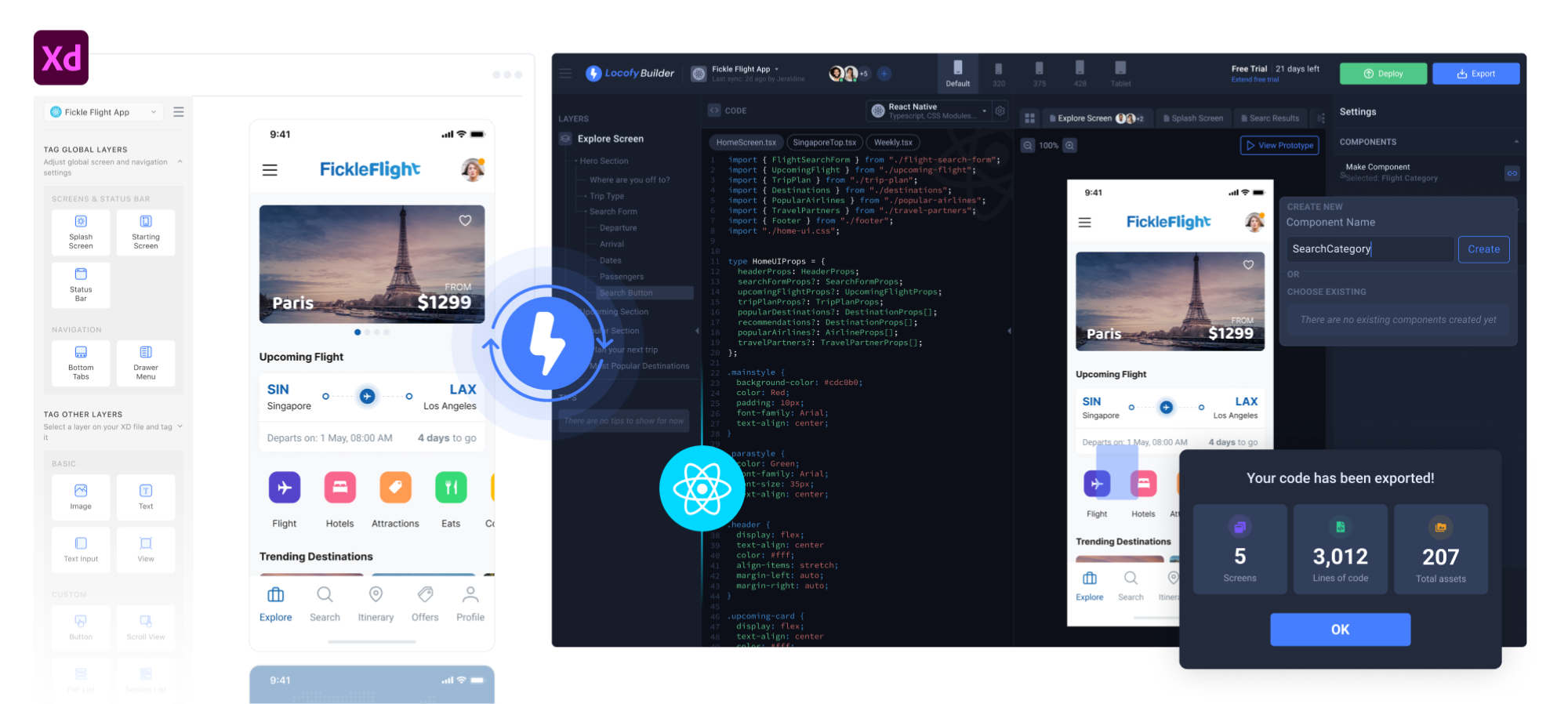Adobe XD to React Native conversion involves transforming design files into functional mobile applications. This process bridges the gap between design and development.
Designers create visually appealing interfaces using Adobe XD. Developers then convert these designs into interactive React Native components. This method ensures a seamless user experience across various devices. Utilizing Adobe XD for design and React Native for development streamlines the workflow.
This approach saves time and reduces errors. It also promotes collaboration between designers and developers. Tools like XD2React or Avocode can simplify the conversion process. These tools help in extracting design elements and generating code. Efficient conversion from Adobe XD to React Native boosts productivity and enhances app quality. This integrated approach is essential for modern app development.

Credit: m.youtube.com
Benefits Of Integration
Integrating Adobe Xd with React Native online offers numerous advantages. Designers and developers can now work more efficiently. This integration streamlines the entire process from design to deployment.
Streamlined Design Process
The integration between Adobe Xd and React Native simplifies the design process. Designers can create interactive prototypes in Adobe Xd. These prototypes can be directly converted into React Native code. This eliminates the need for manual coding.
Designers and developers can now collaborate seamlessly. Changes made in Adobe Xd are instantly reflected in the code. This reduces errors and ensures design consistency.
Faster Development Cycles
With this integration, development cycles become much shorter. Designers can quickly turn their visions into reality. Developers can focus on functionality instead of translating designs into code.
Teams can launch products faster. This gives businesses a competitive edge in the market. Faster iterations lead to quicker feedback and improvements.
Consistent User Experience
Maintaining a consistent user experience is crucial. Adobe Xd to React Native integration ensures this. The design stays true across all platforms and devices.
Consistency is key for user satisfaction. A unified design language builds trust with the users. It enhances the overall user experience.
With Adobe Xd and React Native, you get a coherent and polished app. Users will appreciate the seamless experience.

Credit: mockitt.wondershare.com
Setting Up Adobe Xd
Adobe Xd is a powerful tool for UI/UX designers. It helps create stunning app designs. Setting up Adobe Xd is simple. Follow these steps to get started quickly.
Installation Guide
To install Adobe Xd, follow these steps:
- Go to the Adobe Xd official site.
- Click on the “Download” button.
- Sign in or create an Adobe account.
- Follow the on-screen instructions to install.
Once installed, open Adobe Xd from your desktop. Now, you are ready to explore its features.
Basic Features Overview
Adobe Xd offers various features to design apps easily. Here are some key features:
- Artboards: Create multiple screens for your app.
- Components: Reusable elements for consistency.
- Repeat Grid: Quickly create lists and grids.
- Prototyping: Link screens to create interactive prototypes.
These features make designing intuitive and efficient.
Creating Your First Design
Ready to create your first design in Adobe Xd? Follow these steps:
- Open Adobe Xd and click on “New File”.
- Select the desired artboard size.
- Use the toolbar to add shapes, text, and images.
- Arrange elements on your artboard.
- Save your design by clicking “File” then “Save”.
Congratulations! You have created your first design in Adobe Xd. Now, you can move on to more advanced features.
Exporting From Adobe Xd
Exporting from Adobe Xd to React Native is simple. Follow this guide to ensure smooth transitions.
Export Options
Adobe Xd offers multiple export options. Choose the one that fits your needs best.
- Design Specs: Use for sharing design specifications.
- Assets: Export images, icons, and graphics.
- Code: Generate CSS or HTML code snippets.
Preparing Assets For React Native
Properly prepare assets for React Native. This ensures better performance and compatibility.
- Optimize Images: Compress images to reduce load time.
- Use SVGs: Prefer SVGs for scalable graphics.
- Export Icons: Export icons in multiple sizes.
Best Practices
Follow these best practices for a seamless export process.
- Consistent Naming: Name layers and groups clearly.
- Use Grids: Align elements to a grid for uniformity.
- Component Reuse: Reuse components to save time.
| Step | Action | Benefit |
|---|---|---|
| 1 | Export Design Specs | Easy collaboration with developers |
| 2 | Optimize Images | Faster load times |
| 3 | Use SVGs | Scalable and resolution-independent |
Introduction To React Native
React Native is a popular framework for building mobile apps. It uses JavaScript and allows developers to create apps for both Android and iOS. The framework offers a rich set of features and tools. These help in building high-performance mobile applications.
Installation Guide
Getting started with React Native is simple. Follow these steps:
- Install Node.js from the official website.
- Use the command
npm install -g expo-clito install Expo CLI. - Create a new project with
expo init my-new-project. - Navigate to your project folder and run
npm start.
Basic Features Overview
React Native offers several basic features:
- Hot Reloading: See changes instantly without restarting the app.
- Components: Reusable pieces of UI like buttons and text boxes.
- Cross-Platform: Write once, run on both Android and iOS.
- Live Reloading: Refresh the app automatically after saving changes.
Creating Your First App
Let’s create your first React Native app:
- Open your terminal and type
expo init FirstApp. - Choose a template and navigate to the new directory.
- Run
npm startto start the development server. - Open the app in the Expo client on your phone.
You have now created your first React Native app!
Integrating Designs Into React Native
Integrating Adobe XD designs into React Native apps can be a rewarding experience. This process bridges the gap between design and development, ensuring your app looks stunning and works perfectly. Here, we will explore different methods to achieve this integration.
Using Plugins
Plugins can simplify the process of converting Adobe XD designs to React Native code. These tools automate code generation, saving time and reducing errors. XD to React Native plugins are very popular.
- Install the plugin in Adobe XD.
- Export your design using the plugin.
- Import the generated code into your React Native project.
This method is quick and efficient. It ensures your design elements are accurately translated into code.
Manual Integration
Manual integration requires more effort but offers greater control. Here, developers translate Adobe XD designs into React Native code step-by-step.
- Export assets from Adobe XD.
- Use CSS-in-JS libraries like Styled Components.
- Map out the design structure in your React Native components.
This method is best for complex designs where precision is key.
Common Challenges
Integrating designs into React Native can present some challenges. Understanding these can help you prepare and resolve them efficiently.
- Inconsistent Spacing: Ensure pixel-perfect accuracy by checking spacing values.
- Font Rendering: Different platforms render fonts differently. Test on multiple devices.
- Asset Management: Properly organize and name your assets to avoid confusion.
Awareness of these challenges can streamline your integration process and result in a polished app.
Testing And Debugging
Testing and debugging are crucial stages in converting Adobe Xd designs to React Native apps. These steps ensure the app works perfectly and offers a great user experience. Let’s explore the tools and tips to make this process easier and more effective.
Testing Tools
Using the right testing tools can save time and effort. Some popular tools include:
- Jest: A JavaScript testing framework for React Native.
- Detox: An end-to-end testing library for mobile apps.
- React Native Testing Library: Helps in testing React Native components.
These tools help in identifying bugs early and ensure the app behaves as expected.
Debugging Tips
Effective debugging can make the development process smoother. Here are some tips:
- Use React Native Debugger to inspect and fix issues.
- Check for errors in the console and resolve them promptly.
- Utilize breakpoints to pause code execution and examine variables.
- Keep an eye on network requests to identify issues with data fetching.
These tips can help in quickly resolving issues and improving the app’s quality.
Optimizing Performance
Performance optimization is essential for a smooth user experience. Consider these strategies:
- Minimize re-renders by using
shouldComponentUpdateorReact.memo. - Optimize image loading by using appropriate image formats and sizes.
- Use FlatList for rendering large lists efficiently.
- Ensure efficient state management with tools like Redux or MobX.
These practices help in making the app fast and responsive, enhancing user satisfaction.
Advanced Techniques
Using advanced techniques can transform your Adobe XD designs into powerful React Native applications. These techniques help in creating visually appealing and functional apps. Understanding them can elevate your skills to the next level.
Animations And Transitions
Animations and transitions breathe life into static designs. They make the user experience engaging. React Native offers several libraries for this purpose.
- React Native Animated API: Provides basic animation capabilities.
- React Navigation: Offers transitions between screens.
- Lottie for React Native: Integrates complex animations easily.
Using these libraries can make your app more interactive. They help in creating smooth and engaging user experiences.
Responsive Design
Creating a responsive design ensures your app works on all devices. React Native’s Flexbox layout system helps achieve this.
| Flexbox Property | Description |
|---|---|
| flexDirection | Defines the primary axis. |
| justifyContent | Aligns children along the primary axis. |
| alignItems | Aligns children along the secondary axis. |
Using Flexbox properties ensures your design adapts well. It creates a consistent look across different screen sizes.
State Management
State management is crucial for managing data flow in your app. React Native offers several state management solutions.
- React’s useState Hook: Manages local component state.
- Context API: Shares state across multiple components.
- Redux: Manages complex state across the app.
Choosing the right state management solution can improve your app’s performance. It makes the development process more manageable.

Credit: mockitt.wondershare.com
Case Studies
Understanding real-world applications is key to mastering Adobe Xd to React Native. Let’s explore some case studies that highlight the journey from design to code.
Real-world Examples
Many companies have successfully converted their Adobe Xd designs to React Native. Here are a few examples:
| Company | Project | Outcome |
|---|---|---|
| ABC Corp | Mobile App Redesign | Increased user engagement by 25% |
| XYZ Ltd | E-commerce App | Boosted sales by 40% |
| 123 Inc | Social Media App | Enhanced user experience |
Lessons Learned
- Consistency is Key: Maintain a consistent design language.
- Test Early and Often: Regular testing catches issues early.
- Collaboration Matters: Designers and developers should work closely.
Best Practices
- Use Components: Break down designs into reusable components.
- Keep It Simple: Avoid overly complex designs.
- Optimize Assets: Use optimized images and icons.
- Document Everything: Keep detailed documentation of design choices.
Frequently Asked Questions
What Is Adobe Xd To React Native?
Adobe XD to React Native is a process that converts design prototypes from Adobe XD into React Native code. This helps in speeding up mobile app development.
How To Convert Adobe Xd To React Native?
To convert Adobe XD to React Native, use plugins or tools like XD2React. They automate the conversion process, making it efficient.
Why Use Adobe Xd For React Native?
Adobe XD offers a user-friendly interface for designing app prototypes. Converting these designs to React Native code ensures consistency and speeds up development.
Can Adobe Xd Export Directly To React Native?
Adobe XD cannot export directly to React Native. However, plugins and third-party tools can facilitate this conversion process effectively.
Conclusion
Transforming Adobe XD designs into React Native code has never been easier. Leverage these tools for efficiency and accuracy. Simplify your development process and bring your creative visions to life. Stay ahead in the competitive app market by mastering these conversion techniques.
Start today and enhance your design-to-development workflow.
Adobe Xd to React Native Online, Adobe Xd to React Native Online, Adobe Xd to React Native Online, Adobe Xd to React Native Online, Adobe Xd to React Native Online, Adobe Xd to React Native Online, Adobe Xd to React Native Online, Adobe Xd to React Native Online, Adobe Xd to React Native Online, Adobe Xd to React Native Online, Adobe Xd to React Native Online, Adobe Xd to React Native Online,
Adobe Xd to React Native Online, Adobe Xd to React Native Online, Adobe Xd to React Native Online, Adobe Xd to React Native Online, Adobe Xd to React Native Online, Adobe Xd to React Native Online, Adobe Xd to React Native Online,

I’m an American blogger and software writer. I’ve been writing about the newest developments in the computer sector for more than 4 years, specializing in subjects like artificial intelligence,
cybersecurity, and new software updates.
